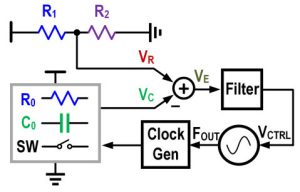RC oscillators can be small or accurate, and now that can be both after Delft University of Technology*, Silicon Integrated and Tsinghua University revealed a 10MHz RC oscillator with ±0.28% accuracy over -45 to 125°V after a one-point trim, fabricated with a 0.01mm2 footprint in standard 0.18μm CMOS.
The scheme avoids needing the need for resistors with opposing temperature coefficients, which are not available on all processes.

Instead it uses a frequency-locked loop where the RC and a switch act as a frequency to voltage converter for an oscillator (see diagram).
The resulting voltage is compared with another one, this time from a potentiometer made from R1, a p-poly (-0.02%/°C) resistor and R2 a trimmable combination of p-poly and n-poly (-0.15%/°C).
The oscillator is voltage-controlled, and driven by the difference (via an integrator) between the RC-derived voltage and the potentiometer voltage – making the frequency-locked loop.
C in RC is a metal-insulator-metal capacitor with a coefficient of ~30ppm/°C, and R is another -0.02%/°C p-poly resistor.
With cunning design, R2 can be made to keep the same resistance value but have its coefficient swept across -40ppm/°C to 40ppm/°C in 16 steps by a digital trimming code – making temperature coefficient of the whole oscillator trimmable, allowing overall drift to be minimised.
As C is implemented as a capacitive DAC, frequency can also be trimmed digitally.
Consumption of the 100 x 100μm block is 27.5μA analogue plus 29.2μA digital (most for the output buffer) from 1.5V. Over 1.5 to 1.8V, frequency shifts 2,700ppm.
The temperature response is a hill, with 9.987MHz (on average) at -40 and +125°C, and 10.01MHz at 40°C with rising temperature, or 10.02MHz 40°C with falling temperature – the different values a result of hysteresis (1,500ppm worst-case).
Ageing at at 150°C for a week revealed drift, which is work-in-progress.
In another RC oscillator paper at ISSCC 2023, the University of Illinois, Urbana looked deep into the ageing of RC oscillators, pointed the finger at drifty p-poly resistors, and revealed a 100MHz oscillator with ±1,030ppm inaccuracy across -40 to 85°C after soaking at 125°C for 500 hours.
Its compensation scheme achieved a 1,000 hour 125°C drift of 500ppm, compared with 5,000ppm of aging drift without compensation.
The design is also a frequency-locked loop, but without the temperature-response-adjusted voltage reference.
This is a far more complex oscillator that the one above, finally occupying 0.22mm2 on a 65nm CMOS die, packaged in a plastic QFN.
Many things were discovered that can be exploited to improve accuracy over time.
One finding was that p-poly resistors drift a lot with age, while n-poly and via resistors are better.
Another was that current in one direction through some on-die components makes them age in one direction, sometimes through electro-migration, so they drift less if the architecture makes current flow in both directions as the oscillator cycles.
The third significant discovery was that simply operating makes an RC oscillator drift as time goes by, while an un-powered oscillator on the same substrate drifts far less.
Armed with the last piece of information, the final design has a continuously running oscillator, plus another oscillator that is only run briefly (once an hour) at 0.1% duty cycle. This output of this ‘young’ oscillator is used to update the calibration of the continuous oscillator.
Consumption is 1.4μW/MHz.
ISSCC 2023 paper 3.4
A 0.01mm2 10MHz RC frequency reference with a 1-point on-chip-trimmed inaccuracy of ±0.28% from -45°C to 125°C in 0.18μm CMOS
ISSCC 2023 paper 3.5
A 1.4μW/MHz 100MHz RC oscillator with ±1030ppm inaccuracy from -40°C to 85°C after accelerated aging for 500 hours at 125°C
*see also Delft University of Technology in Electronics Weekly’s ISSCC 2023 Class-D amplifier article here
The IEEE International Solid-State Circuits Conference, held annually in San Francisco, is a world showcase for IC-based analogue, digital and RF circuity. It offers an opportunity for IC and circuit design engineers to maintain technical currency, and to network with experts.
